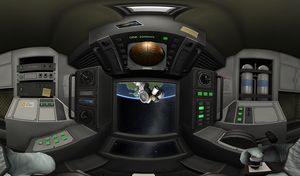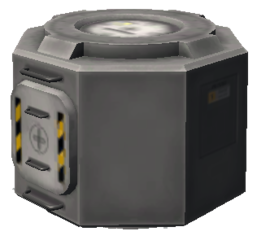Difference between revisions of "Mk1 Lander Can"
m (→Changes) |
(→Usage) |
||
| Line 10: | Line 10: | ||
The main downside to the Mk1 Lander Can is that it is a very fragile module which cannot withstand impact forces more significant than 8 m/s. Attempting to land after any landing gear has was damaged has occurred is very risky and requires a prolonged and controlled descent. Though a fragile module, a critical trade-off is that it is incredibly light and becomes a critical part to use in situations where a good deal of delta-V is required. | The main downside to the Mk1 Lander Can is that it is a very fragile module which cannot withstand impact forces more significant than 8 m/s. Attempting to land after any landing gear has was damaged has occurred is very risky and requires a prolonged and controlled descent. Though a fragile module, a critical trade-off is that it is incredibly light and becomes a critical part to use in situations where a good deal of delta-V is required. | ||
| − | The [[Mk2 Lander-can]] is an upgrade over the Mk1 | + | The [[Mk2 Lander-can]] is an upgrade over the Mk1 (despite being from [[Sean's Cannery|a different manufacturer entirely]] which is over double the mass and can house two Kerbal crewmembers. Though at times unwieldy and top-heavy, a double-stacked Mk1 Lander Can still maintain a smaller mass and cost compared to the Mk2. With this option, two crew members total (one in each lander can) are deployable in a lighter and cheaper setup without having to utilize the larger Mk2 Lander Can. |
== Pros and Cons == | == Pros and Cons == | ||
Revision as of 04:09, 2 April 2020
| Mk1 Lander Can | |||||
| Command pod by Jebediah Kerman's Junkyard and Spacecraft Parts Co | |||||
| Radial size | Small | ||||
| Cost | (total) | 1 535.00 | |||
| (dry) | 1 482.00 | ||||
| Mass | (total) | 0.660 t | |||
| (dry) | 0.506 t | ||||
| Drag | 0.2 | ||||
| Max. Temp. | 2000 K | ||||
| Impact Tolerance | 12 m/s | ||||
| Research | | ||||
| Unlock cost | 6 800 | ||||
| Since version | 0.20 | ||||
| Part configuration | mk1LanderCan.cfg | ||||
| Crew capacity | (maximum) | 1 | |||
| (required) | 1 | ||||
| SAS level | × None | ||||
| Torque | 3 kN·m | ||||
| Electricity required |
| ||||
| Experiment | Crew Report | ||||
| Collectable | No | ||||
| Rerunnable | Yes | ||||
| Resettable | Yes | ||||
| Electricity required | None | ||||
| Antenna type | Internal | ||||
| Antenna rating | 5 km | ||||
| Packed volume | None | ||||
| Inventory Slots | 1 slots | ||||
| Volume limit | 40 l | ||||
| Monopropellant | 15 | ||||
| Electric capacity | 50 ⚡ | ||||
The Mk1 Lander Can is a Command Module housing a maximum of one Kerbal crew member during its mission. The cockpit in the command module is designed for landing and has a "down" looking window to facilitate such activities while piloting from inside the lander can.
Usage

The Mk1 Lander Can, as the name suggests, is an excellent choice to utilize as a base part for both a moon or planetary lander. This command module had two large windows, one facing out from the pilot seat and one angled down to allow the pilot to view the ground approaching while landing. On the exterior of the lander can, the flat octagonal surfaces allow for secure attachment of radial engines, landing gear, science equipment, or any other necessary equipment. Both the top and bottom surfaces of the lander can are adequate to install engines, fuel tanks, RCS bladders, or even a docking port.
The main downside to the Mk1 Lander Can is that it is a very fragile module which cannot withstand impact forces more significant than 8 m/s. Attempting to land after any landing gear has was damaged has occurred is very risky and requires a prolonged and controlled descent. Though a fragile module, a critical trade-off is that it is incredibly light and becomes a critical part to use in situations where a good deal of delta-V is required.
The Mk2 Lander-can is an upgrade over the Mk1 (despite being from a different manufacturer entirely which is over double the mass and can house two Kerbal crewmembers. Though at times unwieldy and top-heavy, a double-stacked Mk1 Lander Can still maintain a smaller mass and cost compared to the Mk2. With this option, two crew members total (one in each lander can) are deployable in a lighter and cheaper setup without having to utilize the larger Mk2 Lander Can.
Pros and Cons
Pros:
- Extremely lightweight
- Excellent command module choice for smaller landing vehicles
- Cheap cost, easy for early explorers without a lot of money
- Multiple surfaces for connecting landing gear, engines, fuel tanks, communication gear, and science equipment
- Window configuration allows 1st person pilot view of the ground from inside while landing
Cons:
- Fragile, cannot withstand impacts greater than 8 m/s
- Can only hold a single Kerbal crew member
- Small size makes it easy to over-burden with equipment
Product description
| “ | This capsule was designed for lightweight non-atmospheric landers, and seats a single occupant. Features a novel full-body crumple-zone technology. — Jebediah Kerman's Junkyard and Spacecraft Parts Co |
” |
Trivia
- There's a photo of Kerbin hanging above the pilot.
- There are two sticky notes in the cabin:
| “ | Reminder: Close the hatch! And don't forget the snacks — Over the control panel above you |
” |
| “ | Software glitch Update before flight DONT FORGET — On the left side under some switches |
” |
- A pre-flight checklist is hanging on the right side of the cabin.
| “ | PRE-FLIGHT CHECKLIST ☐ Get permission to use ship — Pre-flight checklist |
” |
Changes
- Increased crashTolerance from 8 to 12
- IVA improved
- Initial Release
